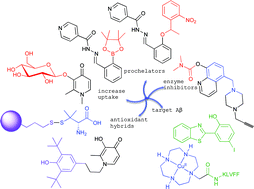Minding metals: Tailoring multifunctional chelating agents for neurodegenerative disease
Abstract
Neurodegenerative diseases like Alzheimer's and Parkinson's disease are associated with elevated levels of

* Corresponding authors
a
Department of Chemistry, Duke University, Durham, NC, USA
E-mail:
katherine.franz@duke.edu
Fax: +1 919 660 1605
Tel: +1 919 660 1541
Neurodegenerative diseases like Alzheimer's and Parkinson's disease are associated with elevated levels of

 Please wait while we load your content...
Something went wrong. Try again?
Please wait while we load your content...
Something went wrong. Try again?
L. R. Perez and K. J. Franz, Dalton Trans., 2010, 39, 2177 DOI: 10.1039/B919237A
To request permission to reproduce material from this article, please go to the Copyright Clearance Center request page.
If you are an author contributing to an RSC publication, you do not need to request permission provided correct acknowledgement is given.
If you are the author of this article, you do not need to request permission to reproduce figures and diagrams provided correct acknowledgement is given. If you want to reproduce the whole article in a third-party publication (excluding your thesis/dissertation for which permission is not required) please go to the Copyright Clearance Center request page.
Read more about how to correctly acknowledge RSC content.
 Fetching data from CrossRef.
Fetching data from CrossRef.
This may take some time to load.
Loading related content
